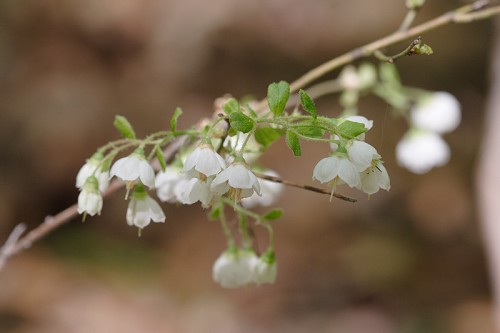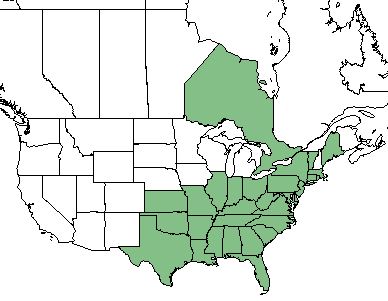Difference between revisions of "Vaccinium stamineum"
| Line 33: | Line 33: | ||
===Habitat=== <!--Natural communities, human disturbed habitats, topography, hydrology, soils, light, fire regime requirements for removal of competition, etc.--> | ===Habitat=== <!--Natural communities, human disturbed habitats, topography, hydrology, soils, light, fire regime requirements for removal of competition, etc.--> | ||
''V. stamineum'' proliferates in pinelands, xeric to submesic woodlands and forests, including pineoak/heath and shrub balds, pine flatwoods, and rock outcrops (unlike most Vaccinium, often on mafic, ultramafic, or calcareous rocks). <ref name= "Weakley 2015"> Weakley, A. S. (2015). Flora of the Southern and Mid-Atlantic States. Chapel Hill, NC, University of North Carolina Herbarium. </ref> | ''V. stamineum'' proliferates in pinelands, xeric to submesic woodlands and forests, including pineoak/heath and shrub balds, pine flatwoods, and rock outcrops (unlike most Vaccinium, often on mafic, ultramafic, or calcareous rocks). <ref name= "Weakley 2015"> Weakley, A. S. (2015). Flora of the Southern and Mid-Atlantic States. Chapel Hill, NC, University of North Carolina Herbarium. </ref> | ||
| + | Specimens have been collected from planted pine in sand ridge, drying loamy sands, old field, slash pine scrub oak, longleaf pineland, mesic hammock, mixed hardwood forest, floodplain, hardwood hammock, and recently burned pineland. Florida State University Robert K. Godfrey Herbarium database. URL: http://herbarium.bio.fsu.edu. Last accessed: June 2014. Collectors: Robert K. Godfrey, Loran C. Anderson, Travis MacClendon, Karen MacClendon, Bian Tan, Scott Zona, Gary R. Knight, Richard S. Mitchell, K. Craddock Burks, D. L. Fichtner, R. A. Norris, R. F. Doren, K. M. Meyer, A. Townesmith, T. E. Smith, J. Beckner, W. G. D’Arcy, Annemarie Post, Cecil R. Slaughter, Sidney McDaniel, Leon Neel, R. Komarek, Richard Carter. States and Counties: Florida: Bay, Calhoun, Columbia, Escambia, Franklin, Gadsden, Jackson, Jefferson, Lafayette, Leon, Liberty, Madison, Marion, Okaloosa, Santa Rosa, Sarasota, St. Johns, Suwannee, Wakulla, and Washington. Georgia: Atkinson, Brooks, Grady, Taylor, and Thomas. | ||
| + | |||
===Phenology=== <!--Timing off flowering, fruiting, seed dispersal, and environmental triggers. Cite PanFlora website if appropriate: http://www.gilnelson.com/PanFlora/ --> | ===Phenology=== <!--Timing off flowering, fruiting, seed dispersal, and environmental triggers. Cite PanFlora website if appropriate: http://www.gilnelson.com/PanFlora/ --> | ||
''V. stamineum'' flowers February-May and July. <ref name= "PanFlora"> PanFlora Author: Gil Nelson URL: [http://www.gilnelson.com/PanFlora/ http://www.gilnelson.com/PanFlora/] Date Accessed: 5/29/18 </ref> | ''V. stamineum'' flowers February-May and July. <ref name= "PanFlora"> PanFlora Author: Gil Nelson URL: [http://www.gilnelson.com/PanFlora/ http://www.gilnelson.com/PanFlora/] Date Accessed: 5/29/18 </ref> | ||
Revision as of 16:42, 22 June 2018
Common name: dwarf deerberry [1], Appalachian deerberry [1], Florida deerberry [1], whiteleaf deerberry [1], southern deerberry [1], common deerberry [1]
| Vaccinium stamineum | |
|---|---|

| |
| Photo by John Gwaltney hosted at Southeastern Flora.com | |
| Scientific classification | |
| Kingdom: | Plantae |
| Division: | Magnoliophyta - Flowering plants |
| Class: | Magnoliopsida - Dicots |
| Order: | Ericales |
| Family: | Ericaceae |
| Genus: | Vaccinium |
| Species: | V. stamineum |
| Binomial name | |
| Vaccinium stamineum L. | |

| |
| Natural range of Vaccinium stamineum from USDA NRCS Plants Database. | |
Contents
Taxonomic Notes
Synonyms: (for var. 2) Polycodium candicans Small; V. candicans (C. Mohr) Sleumer; (for var. glandulosum) Polycodium glandulosum W.W. Ashe; (for var. sericeum) Polycodium sericeum (C. Mohr) C.B. Robinson
Varieties: Vaccinium stamineum Linnaeus var. 1; Vaccinium stamineum Linnaeus var. 2; Vaccinium stamineum Linnaeus var. caesium (Greene) D.B. Ward; Vaccinium stamineum Linnaeus var. glandulosum (W.W. Ashe) D.B. Ward; Vaccinium stamineum Linnaeus var. sericeum (C. Mohr) D.B. Ward; Vaccinium stamineum Linnaeus var. stamineum
Description
V. stamineum is a perennial shrub of the Ericaceae family native to North America and Canada. [2]
Distribution
V. stamineum is found in the southeastern corner of the United States from Texas to Maine, as well as the Ontario region of Canada. [2]
Ecology
Habitat
V. stamineum proliferates in pinelands, xeric to submesic woodlands and forests, including pineoak/heath and shrub balds, pine flatwoods, and rock outcrops (unlike most Vaccinium, often on mafic, ultramafic, or calcareous rocks). [1] Specimens have been collected from planted pine in sand ridge, drying loamy sands, old field, slash pine scrub oak, longleaf pineland, mesic hammock, mixed hardwood forest, floodplain, hardwood hammock, and recently burned pineland. Florida State University Robert K. Godfrey Herbarium database. URL: http://herbarium.bio.fsu.edu. Last accessed: June 2014. Collectors: Robert K. Godfrey, Loran C. Anderson, Travis MacClendon, Karen MacClendon, Bian Tan, Scott Zona, Gary R. Knight, Richard S. Mitchell, K. Craddock Burks, D. L. Fichtner, R. A. Norris, R. F. Doren, K. M. Meyer, A. Townesmith, T. E. Smith, J. Beckner, W. G. D’Arcy, Annemarie Post, Cecil R. Slaughter, Sidney McDaniel, Leon Neel, R. Komarek, Richard Carter. States and Counties: Florida: Bay, Calhoun, Columbia, Escambia, Franklin, Gadsden, Jackson, Jefferson, Lafayette, Leon, Liberty, Madison, Marion, Okaloosa, Santa Rosa, Sarasota, St. Johns, Suwannee, Wakulla, and Washington. Georgia: Atkinson, Brooks, Grady, Taylor, and Thomas.
Phenology
V. stamineum flowers February-May and July. [3]
Fire ecology
V. stamineum is not fire resistant but has medium fire tolerance. [2]
Use by animals
V. stamineum has medium palatability for browsing and grazing animals. [2]
Conservation and Management
V. stamineum is listed as endangered by the Vermont Department of Fish and Wildlife Nongame and Natural Heritage Program. [2]
Cultivation and restoration
Photo Gallery
References and notes
- ↑ 1.0 1.1 1.2 1.3 1.4 1.5 1.6 Weakley, A. S. (2015). Flora of the Southern and Mid-Atlantic States. Chapel Hill, NC, University of North Carolina Herbarium.
- ↑ 2.0 2.1 2.2 2.3 2.4 USDA Plant Database https://plants.usda.gov/core/profile?symbol=VAST
- ↑ PanFlora Author: Gil Nelson URL: http://www.gilnelson.com/PanFlora/ Date Accessed: 5/29/18